Northern Leopard Frog
(Lithobates pipiens)
Conservation • Description • Habitat • Biology • Distribution • Taxonomy
|
|
||||||||||||||
Description |
Northern leopard frog is a slim, medium-sized, widely recognized, spotted frog. It is the most common frog in Minnesota. An outbreak of deformities in this species was discovered by school children in LeSueur, Minnesota, in 1995. The Minnesota Pollution Control Agency researched the problem from 1997 through 2000, when funding for the research was discontinued. The cause of the malformations remains unknown. According to the National Biological Information Infrastructure (NBII), research suggests that there is no single cause. The four major environmental factors contributing to the malformations are contaminants, nutritional deficiencies, parasites, and injuries from predators. Adults are 2″ to 3½″ long at maturity. Males are smaller than females. The back (dorsal surface) is smooth to moderately rough. Background color and spotting is variable. Most adults have 2 to 4 rows of black spots on a green background. Some have a greenish-brown or brown background, some have no dorsal spots, and some are brown with flecks of white, brown, or black between the spots. Juveniles may have few or no dorsal spots. The spots on all adults have a whitish or yellowish bordered. Prominent folds on each side of the back (dorsolateral) extend from the head to near the vent. The folds are light on top and dark at the base. They do not angle inward near the vent (anal opening). Males have a pair of inflatable vocal sacs on their shoulders. During breeding season these appear as areas of loose skin. The belly is white or cream-colored. There is a white stripe in the upper jaw. The ear covering (tympanum) is smaller than the eye. The hind legs have dark horizontal bands. The inside of the thighs of the hind legs are pale with a greenish tint. The feet are webbed. Males have thick, dark thumb pads. There are no recognized subspecies of Northern Leopard Frog but there are four color morphs. Most adults have 2 to 4 rows of black spots on a green background (green morph). Some adults have a greenish-brown or brown background (brown morph). The Burnsi morph is brown or green with no dorsal spots. The less common Kandiyohi morph has black mottling or additional black spotting between the spots. |
Size |
2″ to 3½″ |
Voice |
A low pitched snore, lasting 2 to 4 seconds, and occasional clucks or croaks. |
Similar Species |
Pickerel frog (Lithobates palustris) has a light tan background. The spots are squarish. The inside of the thighs of the hind legs are bright yellow. They are found only in trout streams in southeastern Minnesota. |
Habitat |
Damp woodlands and grasslands, always near lakes, ponds, rivers, slow streams, marshes, or wetlands. |
Biology |
Behavior |
|
Lifespan |
5 to 7 years |
Life Cycle |
Adults breed in April and May. With the male still attached, the female lays a single round mass of between 300 and 6,500 black eggs, attached to vegetation just below the water surface. The eggs hatch in 1 to 2 months and tadpoles metamorphose into adults in about 50 days, depending on the weather. After metamorphosis they leave the pond to feed on dry land and to migrate. Mass migrations often occur after heavy rains. Adults reach sexual maturity in 2 or 3 years. They hibernate usually in deep water that does not freeze completely. They live 5 to 7 years. |
Tadpole Food |
Algae, plant tissue, organic debris, and probably some small invertebrates |
Adult Food |
Insects, spiders, snails, earthworms, and other small terrestrial invertebrates. |
Distribution |
||
|
Sources Biodiversity occurrence data published by: Minnesota Biodiversity Atlas (accessed through the Minnesota Biodiversity Atlas Portal, bellatlas.umn.edu, 6/9/2025). |
|
| 6/9/2025 | ||
Occurrence |
||
Very common |
||
Taxonomy |
|
Class |
Amphibia (Amphibians) |
Subclass |
Lissamphibia (modern amphibians) |
Superorder |
Batrachia (amphibians) |
Order |
Anura (Frogs) |
Suborder |
Neobatrachia |
Superfamily |
Ranoidea |
Family |
Ranidae (True Frogs) |
Genus |
Lithobates (American Water Frogs) |
Genus In 2016, a consortium of Rana researchers from Europe, Asia, and North America showed that transferring the species to Lithobates caused problems of paraphyly in other genera. In that same year, Yuan et al. returned all North American true frogs to the genus Rana, using subgenera for all of the well-defined species groups within Rana. AmphibiaWeb uses the name Rana pipiens. |
|
Subordinate Taxa |
|
|
|
Synonyms |
|
Pantherana pipiens Rana pipiens |
|
Common Names |
|
Northern Leopard Frog |
|
Glossary
Dorsal
Referring to the upper surface or back.
Dorsolateral folds
Two parallel lines, one on each side of the back, of raised glandular skin between the back and the sides of most North American frogs of the family Ranidae.
Tympanum
The circular, disk-like membrane that covers the ear opening of some reptiles and amphibians.
Visitor Photos |
||
Share your photo of this amphibian. |
||
This button not working for you? |
||
Luciearl |
 |
I used to see all the time as a child, then none for years. Recently I've seen two. This one at the Crow Wing State Park. |
Lane Keller |
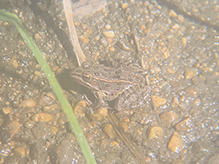 |
Very abundant in Buffalo River State Park especially along the embankment of the river. |
Jeff LeClere |
||
 |
||
| Kandiyohi morph |
|
|
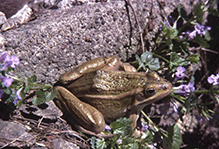 |
 |
|
| Burnsi morph | Burnsi morph |
|
Kirk Nelson |
||
 |
 |
|
Dallas Barber |
||
 |
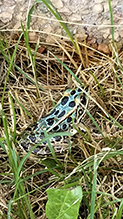 |
|
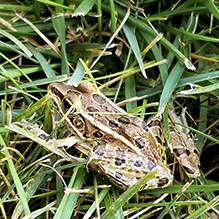 |
||
Margot Avey |
||
 |
 |
|
 |
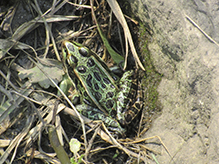 |
|
Lynn Rubey |
||
 |
||
The Northern Leopard Frog jumped in the other tire track of a service road in The Big Stone National Wildlife Refuge. It is a species of the True Frog family, native to North America and the state amphibian of Minnesota. |
||
Gerry Garcia |
 |
Alfredo Colon |
 |
Bill Reynolds |
||
 |
 |
|
 |
||
MinnesotaSeasons.com Photos |
||
 |
 |
|
Green morph |
Green morph |
|

|
 |
|
Brown morph |
||
|
||
|
||
| Brown morph |
|

Slideshows |
Lithobates pipiens (Northern Leopard Frog) |

|
Rana pipiens |

|
Northern Leoprd Frog |

|

Visitor Videos |
||
Share your video of this amphibian. |
||
This button not working for you? |
||
|
Other Videos |
||
Northern Leopard Frog (Lithobates pipiens) |
About
Published on Apr 30, 2012 No description available. |
The Northern Leopard Frog (Ranidae: Lithobates/Rana pipiens) |
About
Uploaded on Dec 21, 2009 A brief contemplative look at the Northern Leopard Frog (Rana pipiens), a common but possibly declining species in the upper midwest of the United States. Specimens shown here were filmed in northeastern North Dakota and northwestern Minnesota in the summer, 2009. |
Northern leopard frogs calling |
About
Uploaded on Mar 20, 2009 Northern leopard frogs calling |
Northern leopard frog (Rana pipiens) mating call |
About
Uploaded on Apr 21, 2009 This is a Northern Leopard Frog calling for a mate. Others can be heard in the background. See also the article on http://thamno.com/blog/?p=1260 |
Leopard frog (Rana pipiens) calling |
About
Uploaded on May 2, 2007 Leopard frog calling. © Ryan M. Bolton www.artofconservation.ca/RMBolton |
Northern Leopard Frog (Ranidae: Lithobates/Rana pipiens) Anterior View |
About
Uploaded on May 14, 2010 Photographed at Kellys Slough NWR, North Dakota (14 May 2010). This is the largest and thinnest leopard frog I've ever seen. I believe that this is a female en route to a wetlands area, 50 m distant, where males are calling this late afternoon. |
Uploaded on Mar 29, 2007 |
About
Uploaded on Mar 29, 2007 Vocalizing Northern Leopard Frogs from New Jersey. Poor video, but mainly for documentation purposes |

Visitor Sightings |
||
Report a sighting of this amphibian. |
||
This button not working for you? |
||
| Luciearl 9/20/2023 |
Location: Crow Wing State Park I used to see all the time as a child, then none for years. Recently I've seen two. This one at the Crow Wing State Park. |
| Lane Keller 9/12/2022 |
Location: Buffalo River State Park Very abundant in Buffalo River State Park especially along the embankment of the river. |
| Kirk Nelson 10/10/2021 |
Location: Minnesota Valley National Wildlife Refuge, Long Meadow Lake Unit |
| Margot Avey 8/29/2019 |
Location: Lake Harriet Gardens, Minneapolis MN |
 |
| Dallas Barber 8/16/2019 |
Location: Cottage Grove |
 |
| Gerry Garcia 8/4/2019 |
Location: Lyndale Park, Minneapolis, MN |
 |
| Alfredo Colon 6/19/2018 |
Location: Woodbury, Minnesota |
 |
| Kirk Nelson 9/10/2017 |
Location: Lebanon Hills Regional Park |
 |
| Margot Avey 8/31/2017 |
Location: Lake Harriet Gardens, Minneapolis MN |
 |
Sandralee Branzovsky |
Location: Long lake, Grandy, MN always surprised to see this frog. Not very many around anymore. |
|
| Bill Reynolds 9/5/2014 |
Location: Pennington Co Mn |
 |
| Jeff LeClere 2008 |
Location: Kandiyohi County |
 |
| Jeff LeClere 2008 |
Location: Ramsey County |
 |
MinnesotaSeasons.com Sightings |
||

Created: 9/17/2004 Last Updated: © MinnesotaSeasons.com. All rights reserved. |






